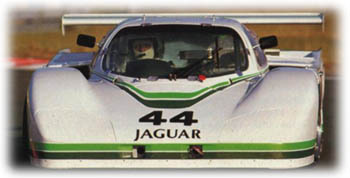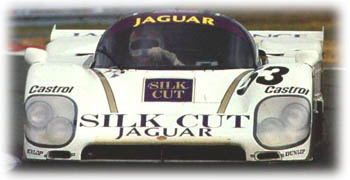|
 This week sees the announcement of a newcomer to Formula One, and yet it is a marque with far better motorsports pedigree than most already in Formula One. Next season, that most British of marquees, the marque most associated with 'British Racing Green' in modern times, with an Irish and an English drivers, and with Scottish management, will see the return of Jaguar to frontline motorsport. This week sees the announcement of a newcomer to Formula One, and yet it is a marque with far better motorsports pedigree than most already in Formula One. Next season, that most British of marquees, the marque most associated with 'British Racing Green' in modern times, with an Irish and an English drivers, and with Scottish management, will see the return of Jaguar to frontline motorsport.
Jaguar today is a name more associated with luxury cars than sports or racing cars. In the past, however, cars such as the C-Type, D-Type and the XJR-12 blasted the tracks of the world and the XK120, E-Type, XJS and XJ220 graced the roads with the Jaguar name.
The Jaguar of today is rooted in the 50's, while the marque goes back well into the 20's. It was the 50's when it became a player on the world stage. Under pressure from the post-war British government, which was rationing steel production towards export industry, Jaguar decided to build a car for the world market. The magnificent XK series engine was designed and Mark V built to house it, but it was thought a flag carrier was needed for the company, so a limited run of open topped sports cars were made using the 3.4 litre XK engine, and the car became the XK120. It was refined, comfortable, relatively cheap and very fast. Orders flooded in and a classic was born.
Three XK120's were taken to the Le Mans in 1950 and against bigger engined opposition were unlucky only to gain a creditable finish. Later in the year one XK120 was loaned, reluctantly, to Tom Wisdom to run for a young Stirling Moss at Dundrod Tourist Trophy. At the stupidly dangerous Irish public road circuit Moss streeted the field, furthering his and Jaguar's reputations.
The logical evolution was to become the C-Type. In 1951 Le Mans one of the unfashionable C-Types defeated the Ferraris and Talbots, a first win for the British marque. After a dismal 1953 Jaguar developed the disk brake and bolted them to the 1953 Le Mans C-Types. The result? A 1-2-4 for Jaguar. Oh, and disk brakes are now a standard feature on every road car...
In 1954 the development of the D-Type began - a semi monocoque construction car, roughly a decade before Lotus introduced the monocoque to Formula One. After early fuel problems at the 1954 Le Mans the leading D-Type finished a mere 105 seconds behind the winning Ferrari.
The classic 1955 Le Mans battle between Jaguar and Mercedes was cut short by the tragic accident where Pierre Levegh's Mercedes rolled into the crowd after a clash with Mike Hawthorn's D-Type and Lance Macklin's Austin Healey. After Mercedes pulled out it was a hollow win for the Jags.  In 1956 a privately run D-Type won Le Mans when the factory cars faltered. One of the large Mark VII saloons won the Monte Carlo Rally, proving Jaguar's competition versatility. The factory pulled out of competition at the end of 1956 although independent D-Types won Le Mans again in 1957. In 1956 a privately run D-Type won Le Mans when the factory cars faltered. One of the large Mark VII saloons won the Monte Carlo Rally, proving Jaguar's competition versatility. The factory pulled out of competition at the end of 1956 although independent D-Types won Le Mans again in 1957.
In 1959 a thorough upgrade of the Mark II saloon would see the Jaguar dominate touring car racing in the early 60's with first the Mark II 3.4, then 3.8 and finally the 4.2. The RAC, Alpine and Monte Carlo rallies all fell to Jags as well. By 1961 a new flag carrier was required and arguably the classic sports car of the 60's, the E-Type was released. The E-Type was a great success on the race track as well.
Jaguar were to take a sabbatical from factory racing that took longer than at first thought.
In the late 70's and early 80's the Jaguar XJS started to make an impact in touring car racing but it wasn't until Tom Walkinshaw Racing came on board that the idea progressed. Walkinshaw's XJS were instantly competitive in the 1982 European Touring Car Championship, threatened BMW's dominance in 1983 and dominated themselves in 1984 with Walkinshaw himself becoming the ETCC Champion. A management decision to transfer the touring car racing image to stable-mate Rover left the Jags in mothballs in 1985, although they came out of retirement to compete in the 1985 Bathurst 1000m which they won.
 At the same time Jaguar was returning to sports car racing with the XJR-5 proving to be competitive. An upgraded XJR-6 appeared in 1985 then the XJR-7 later the same year in the US. For 1987 the European TWR based team developed the XJR-8 and dominated the early season. Specially modified XJR-8LM however failed at Le Mans but the XJR-8 did win the world championship. In 1988 TWR took over the US team and developed the XJR-9 for the US and World series. While front runners in the US, they had to give best to the Sauber-Mercedes team early in the season. At the same time Jaguar was returning to sports car racing with the XJR-5 proving to be competitive. An upgraded XJR-6 appeared in 1985 then the XJR-7 later the same year in the US. For 1987 the European TWR based team developed the XJR-8 and dominated the early season. Specially modified XJR-8LM however failed at Le Mans but the XJR-8 did win the world championship. In 1988 TWR took over the US team and developed the XJR-9 for the US and World series. While front runners in the US, they had to give best to the Sauber-Mercedes team early in the season.
At Le Mans 5 XJR-9LM's were entered and at the end of the 24 hours run, Jaguar made an emotional return to the winners' circle, breaking the Porsche stranglehold on the event. Jan Lammers, Andy Wallace and Johnny Dumfries car never made the finish line as hundreds of British fans flooded the track. Martin Brundle would win the world championship for Jaguar. For 1989 TWR started development of no less than three new models, the XJR-11 for the World series, and the bigger engined XJR-12 for the US series. The XJR-12 was soon the teams long distance speciality and the XJR-10 developed for the shorter US races. The XJR-12 would win Daytona but would lose Le Mans to Mercedes.
 Also in 1989, Ford engineered a take-over, and with consent of the Jaguar board and shareholders Jaguar was bought up from under the noses of General Motors and incorporated into Ford's rear wheel drive product range. By early 1990 Jaguar was a fully owned Ford subsidiary. The XJR-12 would take a near unprecedented 1-2 at the Daytona 24 Hour in 1990 and followed it up with an impressive 1-2 at Le Mans, their 7th and most recent win at Le Sarthe. By 1991 the benefits of an association with Ford filtered through to the racing program. Also in 1989, Ford engineered a take-over, and with consent of the Jaguar board and shareholders Jaguar was bought up from under the noses of General Motors and incorporated into Ford's rear wheel drive product range. By early 1990 Jaguar was a fully owned Ford subsidiary. The XJR-12 would take a near unprecedented 1-2 at the Daytona 24 Hour in 1990 and followed it up with an impressive 1-2 at Le Mans, their 7th and most recent win at Le Sarthe. By 1991 the benefits of an association with Ford filtered through to the racing program.
With the World Sports Car rules changing to 3.5 litre naturally aspirated (Formula One engine regulations) the 7 litre plus XJR-12 and turbo charged XJR-11 models were no longer eligible. The all new XJR-14, one of the prettiest sports car ever, featured a 3.5 litre Ford Cosworth Formula One engine. As fast as the XJR-14 was it was not going to last 24 hours, and with the engine regulations different at Le Mans the XJR-12 made its swansong and would finish 2nd, 3rd and 4th behind the turbo rotary Mazda that had stolen the race.
Road cars originally, the XJR-15 and XJ220 both appeared in 1991. The XJR-15 was a TWR engineered road car of very limited numbers, while the slightly more populous XJ220 was just as expensive and as fast. In 1993 Jaguar made a final recent foray into motorsport with a three car team of XJ220's at Le Mans. One of them won its class but was later disqualified.
 But what does this mean to Formula One? Very little and very much. Jaguar has a great history, but aside from a HWM chassis powered by a Jaguar sports car engine winning the Australian Grand Prix, it has never been in open wheelers. This is a branding exercise for Ford. It allows them to pit their premier luxury brand label against Mercedes-Benz, BMW and Honda, three of its closest market place rivals. However the green paint scheme will inspire a nationalistic fervour for the team, in a similar way the silver McLarens have done in Germany, and of course those red Ferraris. But what does this mean to Formula One? Very little and very much. Jaguar has a great history, but aside from a HWM chassis powered by a Jaguar sports car engine winning the Australian Grand Prix, it has never been in open wheelers. This is a branding exercise for Ford. It allows them to pit their premier luxury brand label against Mercedes-Benz, BMW and Honda, three of its closest market place rivals. However the green paint scheme will inspire a nationalistic fervour for the team, in a similar way the silver McLarens have done in Germany, and of course those red Ferraris.
What does it mean for Eddie Irvine? Number one status in a top team, finally we get a measure of Eddie without the safety net he's had for so many years. For Johnny Herbert? probably not that much, just another name in his long Formula One career, but No.2 to Irvine may grate. It may grate quite a bit.
And what does it mean for Stewart? The name Stewart disappears off the front of the garages, but Jackie and Paul stay at the helm, no doubt still wearing the tartan socks, but thankfully only the socks now. But it will also give Jackie a very self satisfied feeling, he now has a Formula One team with funding and engineering depths to win Grands Prix, perhaps even a World Championship, and, as he set out to achieve in the first place, without a whiff of tobacco money anywhere.
| 
